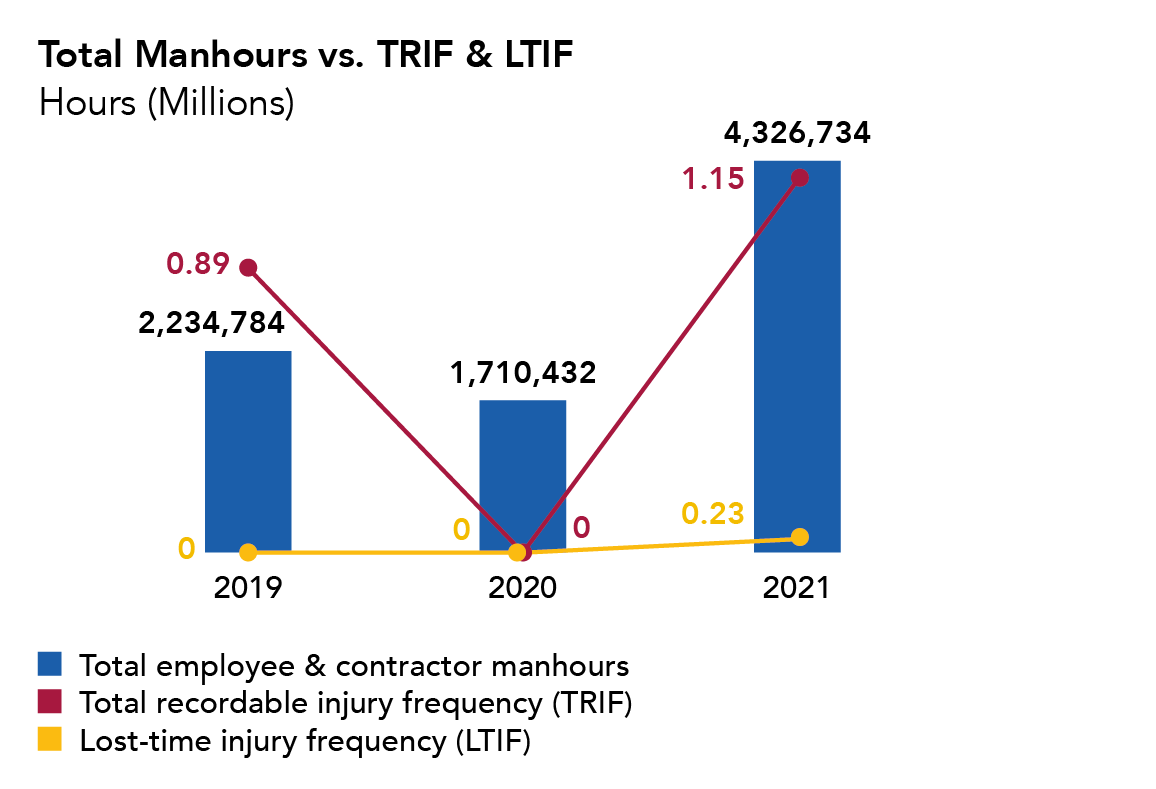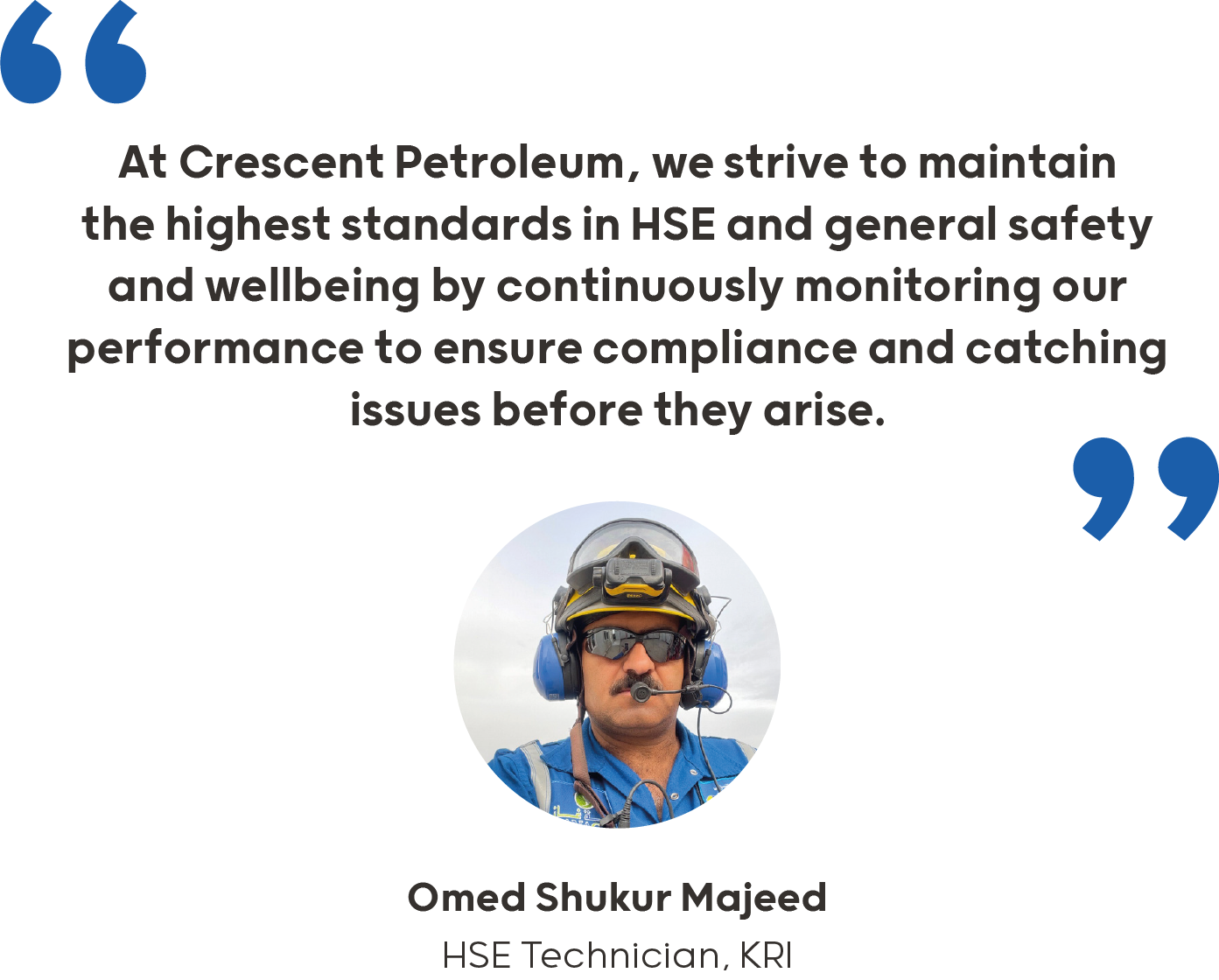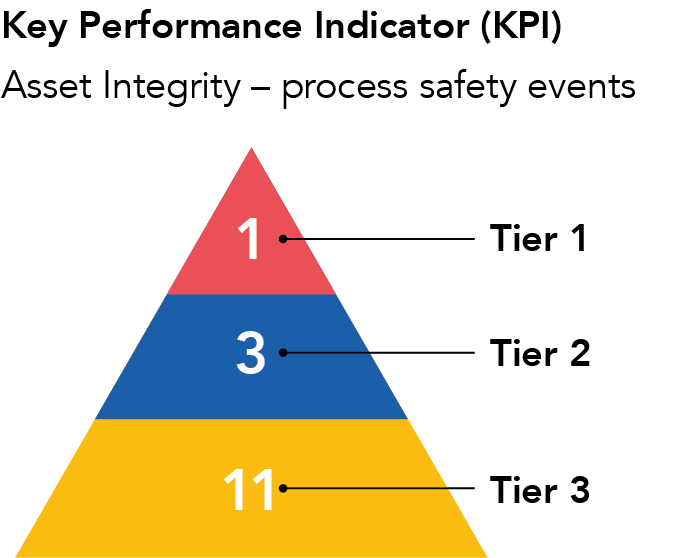Pillar III: Ensuring Our Teams’ Safety
We aim to create a safe and healthy work environment in which the wellbeing of all employees, contractors and partners supersedes all other considerations, both as a good citizen and as a matter of good business.
Material Topics
- Occupational safety
- Security practices
- Process safety, asset integrity and emergency preparedness
![]()
![]()
Ensuring Our People’s Wellbeing
Protecting our employees, contractors, and communities is a top priority at Crescent Petroleum. We actively identify and mitigate health and safety risks and cultivate a culture of safety throughout the organisation to ensure the health and wellbeing is prioritised.
Compensation for operational teams is linked to a scorecard that contains a range ESG-related KPIs, including Total Recordable Injury Frequency (TRIF) Rate, Major Motor Vehicle Incidents Frequency Rate, Number of Closed Asset Integrity Actions, and others related to HSE audits, training, critical maintenance, reliability standards and social investment projects.
Health & Safety
We believe that a culture that encourages and nurtures health and safety leads to increased productivity, better employee retention, and better financial results. We therefore ensure that all hazards inherent to our operations and activities are systematically identified, assessed, and controlled. Our Quality, Health, Safety, Security, and Environment (QHSSE) Policy outlines our commitments and guides our actions.
In 2021, key performance indictors and lessons learned have been shared every month with senior management via a HSE performance dashboard.
Also, in 2021, we adopted the International Oil and Gas Producers Association (IOGP)’s Life Saving Rules, which were established to help mitigate risks and reduce fatalities in the oil and gas industry.
- Permit to work
- Lifting operations
- Energy isolations
- Working at heights
- Driving
- Confined space entry
- Excavation
- Protective equipment
- Simultaneous operations
Communicating knowledge on hazards, risks, and operational controls is effected through mandatory inductions, training, written procedures, “toolbox talks”, awareness programmes, and regular HSE meetings. This approach is applied to all activities under our control, including activities performed by our third party contractors.
We consistently monitor on-site working conditions, including the quality of worker accommodations, through our multi-level KRI Welfare Committee, formed in January 2021.
To ensure that our employees have access to non-occupational medical and health services, we have employee medical facilities on-site in Kurdistan and medivac available to local hospitals. Both our KRI- and UAE-based staff are provided comprehensive medical insurance.
3,000 hrs
Increased total HSE training hours for employees, from over 1,500 hours in 2020 to more than 3,000 hours in 2021.
We promote early reporting of HSSE and Social Performance unsafe act and conditions. To this end in 2021, we recorded more than 4,200 observations company-wide, representing a significant increase compared to 2020, due to primarily the increased activity in 2021 as result of the start of major works on our KM250 project.
All observations and incidents are recorded, mitigated, and closed out in a timely manner. We have also increased total HSE training hours for employees, from over 1,500 hours in 2020 to more than 3,000 hours in 2021, underscoring our commitment to the health and safety of our employees.
Specifically, for our KM250 project, Pearl Petroleum has developed a health, safety, security, environmental and social performance observation card for employees to complete when they observe an incident or intervention or would like to provide a suggestion for improvement. The two-page card includes a request to identify which, if any, life-saving rules are relevant to the observation. The plan is to spread the use of this card into Operations.

Safety Performance
We experienced zero work-related fatalities in 2021, building on many years of zero work-related fatalities at the Khor Mor plant. While we experienced zero employee total recordable injuries again in 2021, we did experience five contractor total recordable injuries associated with our KM250 expansion project, resulting in an increased overall total recordable injury frequency (TRIF) rate for employees and contractors of 1.15. Only one of the contractor injuries resulted in lost time, resulting in a lost-time injury frequency (LTIF) rate to 0.23.
We regard any and all safety incidents as unacceptable and are therefore focused on reinforcing our safety culture and working closely with our contractors to communicate our safety expectations to improve TRIF performance.
We also place considerable emphasis on road safety and preventing work-related vehicle accidents, which is typically a high area of risk. In 2020 and 2021, our employees drove more than 1.6 million kilometres with zero major work-related vehicle incidents.
Contractor Management
Contractors comprise a significant part of Crescent Petroleum’s workforce and play an important role in providing equipment, services, and labour to support our operations and developments. We have established a contractor management process to oversee prequalification, selection, monitoring, and performance reviews. We have additional requirements and processes in place for contractors engaged in the highest risk activities.
During the selection process, the contractors’ HSE systems are assessed to ensure they meet our standards and requirements. Our review includes a full assessment of their programs, past performance, and regulatory compliance. Our bid evaluation includes a thorough assessment and verification of bid submissions, with evaluation outcomes integrated into overall bid selection criteria, alongside technical and commercial criteria.
Crescent Petroleum monitors both its own and its contractors’ systems to ensure their continued effectiveness. We also engage with our contractors at the senior level to ensure that our expectations are clear, and that ongoing performance receives appropriate attention and oversight.
Continuous Improvement
Crescent carried out a series of cross -functional workshops focussed on the theme of continuous improvement. The workshops used an industry standard maturity model called Insight, to assess current status and future aspirations, using a 3-year timescale, and covered HSE management systems, environment, personal safety and process safety. The output was a set of detailed action plans that will be tracked over the forthcoming period. In 2022 this approach shall be extended to Occupational Health, Industrial Hygiene and Sustainability.
Personal safety improvements emanating from the maturity assessment include, but not limited to the following:
- Increasing the level of review required for high-risk activities.
- Developing processes and procedures to mandate site visits prior to and after completion of high-risk activities.
- Addressing audit action items more effectively.
- Embedding IOGP lifesaving rules throughout the organization.
- Developing light vehicle land transportation standard.
- Developing checks to ensure all drivers, including contractors, have completed driver awareness training.
- Extending our driver safety campaign to contract drivers.
- Examining the possibility of extending In-Vehicle Monitoring Systems (IVMS) to all company vehicles.
- Introducing a face mask “fit testing” policy.
- Reviewing and updating personal protective equipment (PPE) guidelines to ensure they are based on an appropriate risk analysis.
- Introducing prescription safety glasses for Khor Mor plant operations personnel.
- Defining on-site hearing protection zones.
- Assessing the risks of hydrogen sulphide, as well as reviewing and revising associated controls.
- Conducting hazardous substance risk assessments and development of a hazardous substance standard.
- Reviewing our behavioural safety approach adopted at site.
- Defining the contractor HSE management process, mapped to include how we categorize contract provision and evaluation criteria and selection throughout all contract phases.
- Reviewing and improving the process for HSE contractor evaluation to be based on service provision and risk category.
| Key Performance Indicator (KPI) Health and Safety |
Units | 2019 | 2020 | 2021 |
| Total employee manhours | # | 1,152,444 | 1,112,256 | 1,741,752 |
| Total contractor manhours | # | 1,082,340 | 598,176 | 2,584,982 |
| Total manhours | # | 2,234,784 | 1,710,432 | 4,326,734 |
| Employee fatalities | # | 0 | 0 | 0 |
| Contractor fatalities | # | 0 | 0 | 0 |
| Employee total recordable injuries | # | 2 | 0 | 0 |
| Contractor total recordable injuries | # | 0 | 0 | 5 |
| Total recordable injuries | # | 2 | 0 | 5 |
| Total recordable injury frequency | # | 0.89 | 0 | 1.15 |
| Employee lost-time injuries | # | 0 | 0 | 0 |
| Contractor lost-time injuries | # | 0 | 0 | 1 |
| Total lost-time injuries | # | 0 | 0 | 1 |
| Lost-time injury frequency (LTIF) | # | 0 | 0 | 0.23 |
| High Potential Incidents (HIPOs) | # | 0 | 2 | 3 |
| Major Road Accidents | # | 0 | 0 | 0 |
| Kilometres driven | # | 0 | 1,691,512 | 1,611,601 |
| Major Vehicle Incident Frequency | # | 0 | 0 | 0 |
| Number of Safety Observations | # | – | 1,448 | 4,262 |
| Observations Actions Close-Out | % | – | 100% | 100% |
| Health and Safety Audits | # | – | – | 12 |
| Total number of health and safety audits for contractors | # | – | – | 3 |
| Health and Safety Training | ||||
| Total hours of HSE training provided | Hours | 7,258 | 1,501 | 3,065 |
From the numerous HSE training courses and activities provided throughout 2021, below is a list of the ten most commonly attended training courses (based on total hours of attendance). We continue to update and revise our training content as new materials, standards and practices are developed and made available.
| Description of HSE Training | Total Number of Attendees | Total Training Hours |
| Working at Heights | 75 | 200 |
| PTW: Performing Authority | 38 | 192 |
| Fire Extinguisher | 67 | 154 |
| Confined Space Entry | 75 | 147 |
| Accident/Incident Reporting and Investigation | 53 | 131 |
| New PTW Users Overview | 41 | 130 |
| Self-Contained Breathing Apparatus (SCBA) | 43 | 105 |
| Camp Tool Box Talk | 418 | 105 |
| H2S Awareness | 62 | 92 |
| Toolbox Talk: HSE | 337 | 87 |
Spotlight: Responding to ongoing COVID-19 challenges in the KRI
We are proud of the resilience and dedication our employees showed during the continuing pandemic, working long hours in challenging circumstances to help us maintain our operations and continue providing critical gas supplies to fuel power plants in the region. We are grateful to all those who ensured that operations continued uninterrupted under particularly challenging conditions.
As the COVID-19 pandemic continued into its second year, Crescent Petroleum continued to apply a number of extraordinary measures to tackle the intersecting challenges of keeping employees healthy and safe, while maintaining productivity in our operations. A dedicated response team met regularly to assess issues and mitigations, reporting to senior management who reviewed risks and action plans in structured weekly meetings. As the situation evolved, so too did control protocols, including testing and quarantine requirements. At all phases, we ensured that staff and contractors remain informed and were aware of ongoing conditions.
As the pandemic became more endemic, we also revised our COVID-19 mitigation strategy from “Keep it Out” to “Keep it Tame.” As vaccines became available in the KRI in April, 2021, we implemented vaccination awareness campaigns and established vaccination requirements for our employees and contractors. By August, 2021, 100% of our staff and contractors on site at the Khor Mor plant had been fully vaccinated. Our strict worksite protocols and controls have remained in place even as normal office working hours were resumed in June 2021, while a mandatory vaccination programme resulted in nearly all staff being vaccinated.

Maintaining Safe & Reliable Operations
At Crescent Petroleum, asset integrity and process safety are an integral part of our QHSSE Policy. Process safety refers to the equipment, procedures, and training that prevents the uncontrolled release of hazardous substances. We use the American Petroleum Institute (API) and IOGP guidance, to define process safety indicators. Some of the ways we assess process safety risks include:
- Hazard identification
- Hazard and operability reviews
- Technical safety assessments, including layers of protection analysis
- Safety integrity level analysis
- Fire and explosion assessments
- Job safety analysis
- Task-based risk assessments
Critical safety elements are defined and appropriate operational, testing and maintenance procedures have been established for all critical systems. Our goal is to prevent incidents with the potential for serious injuries and fatalities, widespread environmental impact, or property damage.
Tier 1 process safety events are defined as those that include loss of primary containment with significant consequences. Tier 2 includes loss of primary containment with less significant consequences, and Tier 3 includes events that challenge our safety systems or near misses.
According to the API, loss of primary containment is defined as an unplanned or uncontrolled release of any material from primary containment, including non-toxic and non-flammable materials.
In 2021, we experienced one Tier 1 process safety event, three Tier 2 process safety events, and 11 Tier 3 process safety events. In each case, we completed a thorough investigation and analysis to determine the root cause of each event. We determined if human factors, procedures, or preventive maintenance were the primary contributing elements and developed mitigation measures and prevention strategies to address all identified issues.

As discussed earlier, an Incident Management Team (IMT) responds to all incidents and responds according to regularly updated Incident Management Plans (IMP) including process safety events. We also have scenario-based local action plans, and intend to establish a Crisis Management Team (CMT) in 2022.
In addition, we have established a target for overdue safety critical maintenance, management of safety system overrides and a resolution of asset integrity inspection action items.
Security
Crescent Petroleum has established strict security arrangements covering all its operations. Our Khor Mor plant is regarded as a national security facility and receives strict government-level security. Our internal security plan provides appropriate protection for personnel and assets, and covers existing operations, remote well and rig locations, and personnel and materials movement. It establishes layers of protection, covering organisation, procedural, and hardware control measures.
Our security plan is based on risk and threat assessments provided by an independent security risk consultancy, and ongoing assessments and risk analysis by Crescent’s Asset Protection department. The assessment methodology considers intent and capability of potential actors, as well as attractiveness of the assets in determining the threat level on a five-point scale. The threat level is then used to determine appropriate response measures, allowing for escalation or de-escalation should atmospherics and assessed threats change.
Regular monitoring of security incidents and intelligence takes place through a variety of means, including subscription services, private security provider reports, and local intelligence.

